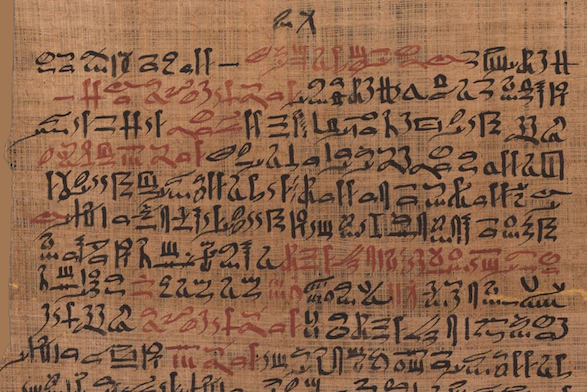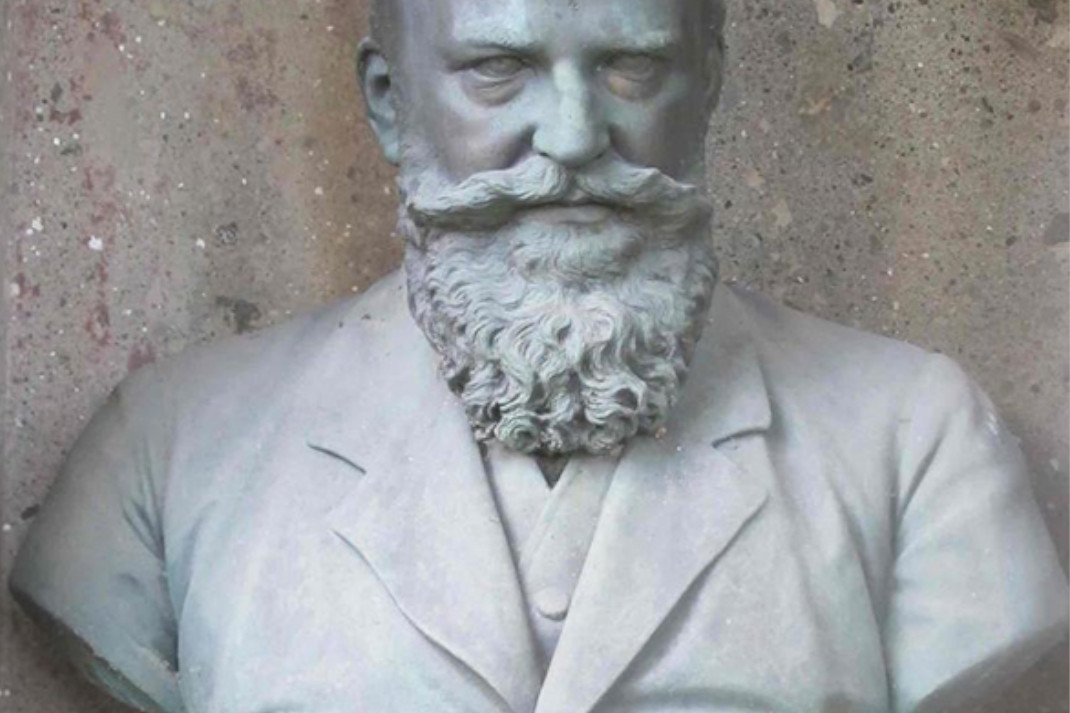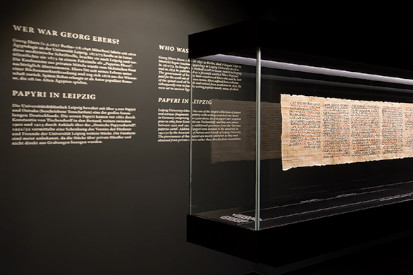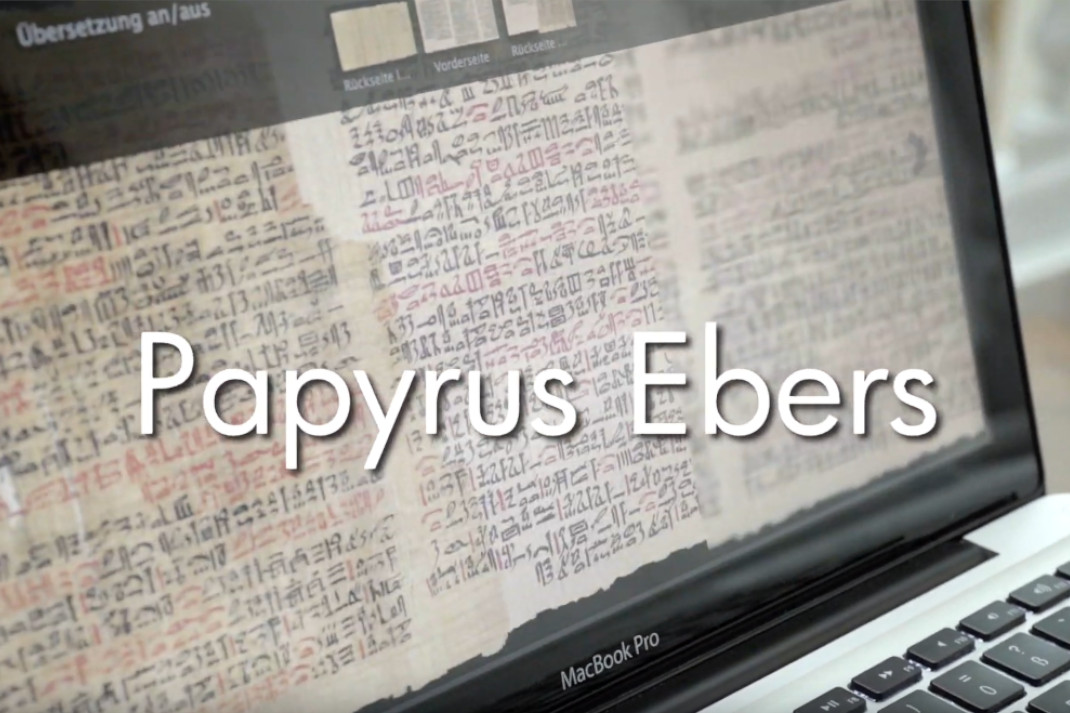Leipzig University Library owns the biggest papyrus scroll devoted to ancient Egyptian medicine and the only one to have been completely preserved. It was acquired for the library in 1873 by the Leipzig Egyptologist Georg Ebers. In 1875, he had a facsimile edition of the text written in hieratic script published.
The entire text complete with translations of all the prescriptions into German and English has been online since 2017. In 2021, a replica of the scroll, which is 18.63 metres long, went on display in a separate showroom in the foyer of Bibliotheca Albertina. (Publication on the Ebers Papyrus showroom, German and English)
Initially studying law in Göttingen, in 1860 Georg Ebers began attending lectures in Berlin by Egyptologist Richard Lepsius. In 1862, he was awarded a doctorate for his thesis on Memnon and the legend surrounding this king of Ethiopia. Subsequently, he travelled extensively in Europe in order to further his education. Ebers aspired to be a distinguished scholar and professor, and also a successful novelist. In 1865 he was appointed an associate professor in Jena. in 1870, he took a professorship at the newly established Egyptology department at Leipzig University.
From 1876 onwards, Ebers was frequently ill and focused almost exclusively on his literary activities. His collected works, published between 1893 and 1897, comprise 32 volumes, 29 of which contain novels and stories as well as his autobiography. Although the literary value of his novels is debatable, they are set in rousing, historically significant eras, for example under Pharaoh Ramses II (Uarda, 1877) and Emperor Hadrian (The Emperor, 1881), in the age of conflict between Christians and pagans (Homo sum, 1878), and during the fall of ancient Egypt (Serapis, 1885).
Georg Ebers died in 1898 in Munich. He was buried in the cemetery in north Munich, where his grave is adorned by a bust of Ebers. (Slider, Fig. 3)
On 26 March 1873, while in Cairo, Georg Ebers wrote to Karl von Gerber, the Saxon Minister of State, as follows:
Your Excellency will be surprised when a box arrives for you from Egypt insured to the amount of 16,000 francs. I am the sender of this treasure, which I have been fortunate enough to acquire. The Consul advises me to send it directly to the Royal Ministry of the Royal House as it must be safeguarded against perils from which not even the consulate seal can provide protection.
The box contains the largest and most beautiful papyrus that Germany has ever possessed, the third-largest of them all. It is so well preserved that not a single page is missing and there are no illegible letters in it. The giant scroll contains 110 pages in sequence. Each of them contains at least 20 lines about 8 inches long. The writing is of astonishing beauty and steadiness. The hierogrammat [scribe] began the sentences in red ink, and wrote the actual text in black ink. I am almost certain that the writing on this papyrus dates back to the XVIII Egyptian dynasty, i.e. the 17th century BC. Our document contains nothing less than a compendium of all Egyptian medicine and begins with the words “Beginning of the book of the diseases of all parts of man.” There follow descriptions of all conceivable ailments with recipes to be applied by the doctor and prayers to be spoken by the patient. There are nine pages alone dedicated to diseases of the eye. On the verso is a very valuable calendar and a text which tells us that our book was attributed to one of the first kings of Egypt. Later it is supposed to have been found at the feet of a statue of Anubis as a symbol of power. …
Lying on the ground next to the papyrus (it had to be rolled up very carefully), strenuously exerting myself, I studied it page by page and have gained an overview of the whole work such that I can assess the main subject of its entire content. It is of the highest interest, not only for the history of medicine. …
I am thinking of publishing the papyrus immediately after my return home – a difficult yet rewarding task. Although the publication of the document can be done quickly, determining the meaning of every single word will take years.
I commend my treasure to Your Excellency’s kind care until my return home (at the end of April). The box containing the fragile papyrus, which is more than 3,000 years old and requires the greatest care, may only be opened by me. I would also ask you to put the box in a dry place, for nothing spoils papyrus more than moisture. …
In addition to the above items, I have managed to acquire such precious new ancient writings that I may gladly say that I have taken full advantage of the vacation period granted to me most graciously.
With the utmost devotion. Your obedient servant, Dr George Ebers. Associate Professor of Egyptology at Leipzig University
Quoted from Dietmar Debes: Zur Erwerbung des Papyrus Ebers, in: Weite Welt und breites Leben. Festschrift für K. Bulling (Zentralblatt f. Bibliothekswesen Beiheft 82), Leipzig 1966, pp. 139–141.
Georg Ebers also analysed ‘his’ papyrus. In his own publication (Georg Ebers: The Weights and Capacities of the Ebers Papyrus, Leipzig, 1889) he examined the various measurements used in the ancient Egyptian prescriptions. At the end he wrote: “Where we have not found a reliable interpretation of the names of the proposed medicines, this is indicated by a question mark.” Research on the scroll is still ongoing.
Ebers studied and translated the eye prescriptions in particular; see p. 295 from G. Ebers: The chapter about eye disorders in the Ebers Papyrus, Leipzig, 1889. Nowadays, some of the substances mentioned are thought to have been incorrectly identified by Ebers.
In 1879 and 1880, two copiously illustrated volumes were published under the title Egypt in pictures and words, depicted by our best artists, described by Georg Ebers. In the preface to the first volume, Ebers wrote: “What is the source of the marvellous attraction inherent in the ancient land of the pharaohs? Why do we have such a different attitude to its name, its history, its natural features and its monuments from those of the other countries of antiquity?” Ebers described himself as a man “who loves and knows oriental Egypt” and wants “to bring together all that is beautiful and venerable, picturesque, characteristic and attractive in ancient and modern Egypt for the people of our time and the future for education and pleasure.” It contains 900 pages and almost as many illustrations.
In his illustrated books, Ebers often looked back at ancient Egypt in the age of the pharaohs and also mentioned magical practices as widespread contemporary remedies (vol. 2, p. 67). He included an engraving after Leopold Carl Müller (1834–1892) showing fortune-tellers reading and interpreting the imprints of human palms. Ebers confirmed that magic spells were also included in the Ebers Papyrus, yet “nevertheless many passages in this work testify to the outstanding knowledge of their authors.”



